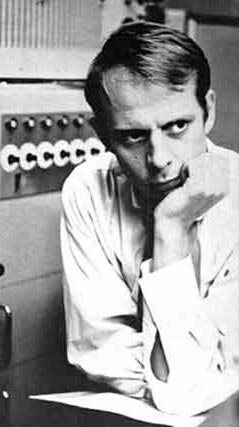 |
The Montreal Stockhausen Project
presented by New Music Concerts and the Goethe Institut |
|
| November 15, 2008 • Enwave Theatre • Toronto |
|
|
|
|
|
|
| Report by Jessica Lombardi |
| The untimely death of composer Karlheinz Stockhausen last December — just one year shy of his 80th birthday — left many of his loyal students and followers to commemorate him this year with dedicated concerts. The Montreal Stockhausen Project was a thoughtfully put together concert; a rare and extraordinary performance that took place at the intimate Enwave Theatre down at the Harbourfront Centre. Some of Stockhausen’s most important works were presented by a devoted ensemble of Montreal musicians who had worked extensively with Stockhausen himself, and who are expert performers of his music.
A legend of the European avant-garde music scene, Stockhausen used all kinds of abstract and concrete sounds as the brickwork for his visionary music. Using natural and synthetic sounds/samples and influencing performers, composers, and listeners alike, he opened the world’s ears to new sound possibilities, to a world of music that had never before been ventured into. Stockhausen produced over three-hundred individual works entirely of their own nature, making breakthroughs in the areas of spatial music, musique concrète (electro-acoustic music), and aleatory techniques in serial composition (that is, using controlled chance formulae in a musical performance).
With some of his space-music pieces, he is able to shift the aural atmosphere of a performance venue to project sounds seemingly without boundaries. This effect calls for a unique set-up of surround-sound speakers within a concert hall in order to facilitate a particular sonic impression. The Enwave Theatre was thus transformed into an ultra-sensitive acoustic environment where the audience flinched at any and all coughs or cracked knuckles.
Gesang der Jünglinge, translated as Song of the Youths, was the first of many unusual works to be presented that evening. The pre-recorded composition used the surround-sound set-up to create the effect of the music circling around the audience in clockwise, counterclockwise and random directions all around them. Another fascinating element was the perceived fusion of electronic sounds with the timbre of a young soprano boy singing. The effect was truly enrapturing for the audience.
|
| Following a short intermission, soloist Lise Daoust performed Flautina — a composition scored for flute, alto-flute, and piccolo. Wearing a belt that held the three instruments to her side, she skillfully alternated between instruments, and each time concealed the silences with musical hums and hahs, in the form of tongue clicks, sighing, whistling, and making kissing and spitting noises. Overall, it was an impressive sight and sound to reflect on.
The piece was Ave — part of a section of Montag entitled Eve’s Magic, from the monumental opera Licht. An entertaining duet between basset-horn player François Duval and alto-flautist Chloé L’Abbé, this performance was full of musical and corporal expressions that conveyed a story (also described in Stockhausen’s program notes). Although the scene spanned a half-hour and lacked words or text of any kind, the plot was easily grasped as the scene was delivered with particular allurement.
A second remarkable number from the same section of Licht, was Entführung (Abduction), with its blending of the piccolo timbre and electronically-produced sounds of children’s vocals, synthesizers, and various percussion noises. The scene was filled with great moments of agile playfulness, as Geneviève Déraspe, adored by the audience, explored the acoustics of the space by dancing and hiding around and behind the set.
|
|

Karlheinz Stockhausen (1964) |
|
| A second intermission facilitated the rearrangement of the stage for the final piece, Kathinkas Gesang. This composition brought together flute and electronic timbres in such a way as to explore together the tonal resonances in natural and synthetic harmonics. Two giant circular boards were equally divided into twelve segments, each one displaying eleven musical phrases and one restful pause. Marie-Hélène Breault was consistent in her character for the half-hour it took to perform this piece, and as she tip-toed around the stage she brought to life imagery of a vast sonic realm that represented Lucifer’s Requiem.
The concert’s program was good for incorporating several genres and style-periods cultivated in the composers’ life; however, the works presented used a limited palette of acoustic timbres and techniques in the vocally produced expressions and woodwind timbres. The concert was also very long, spanning over two hours, including a half-hour pre-show talk (explaining the background and context of the music) plus two intermissions.
As a composer with a broad area of interests other than music — philosophy, phonetics, acoustics, and information theory to name a few) — there is lots of inspiration audible in Stockhausen’s music, although there is a definite peculiarity to it that makes it difficult to interpret. Nevertheless, the vast imagination of his output makes the experience of his music influential to our sonic-awareness.
|
|
|
|
|
|


